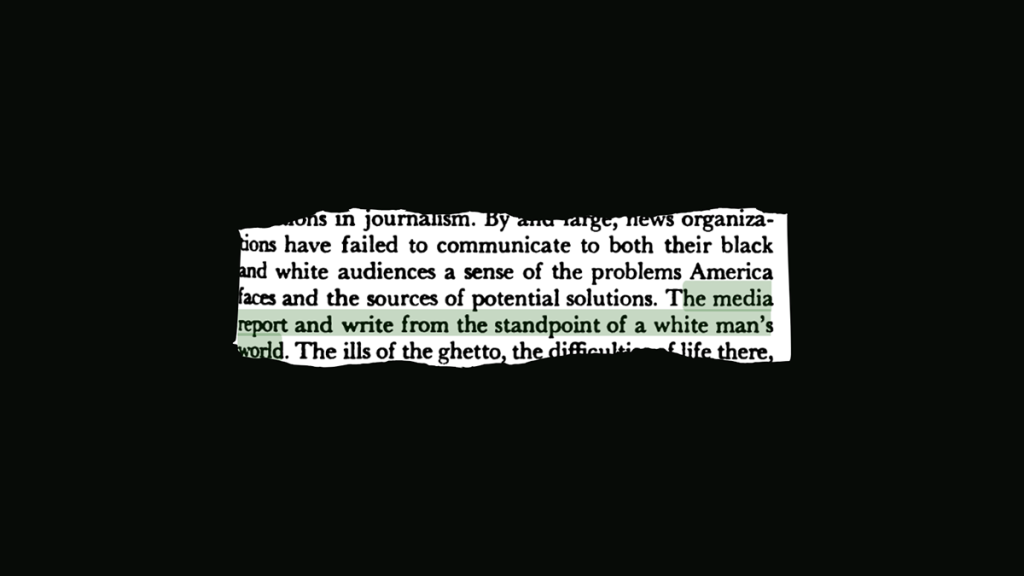
Screenshot of the 1968 Kerner Commission report. Image: James Salanga
Looking at the reactionary response to media’s 2020 ‘reckoning’
It’s not just broken promises at stake. It’s the future of the news and information ecosystem.
The views expressed in this column are those of the author and do not necessarily reflect the views of the Reynolds Journalism Institute or the University of Missouri.
Nearly five years ago, as people took to the streets en masse to protest the murder of George Floyd, the institution of police, and the continuation of systemic racism, Black and brown reporters took their newsrooms to task about their role in perpetuating oppression.
They called out The New York Times for an incendiary Tom Cotton op-ed calling for an “overwhelming use of force” against George Floyd protestors. At the Philadelphia Inquirer, reporters of color and allies organized a sick-out after a top editor greenlighted the headline “Buildings Matter, Too”.
There were some marks of change. Among them: NPR doubled down on making diversity its “north star”, the Inquirer launched an extensive listening tour and research to unveil a community and engagement news desk, editors of color in the U.S. increased, newsrooms rushed to create jobs for and hire reporters focused on race, diversity, and equity.
But “racial reckoning” heralded by news organizations far and wide didn’t really happen — at least, not in the way that was promised.
“Racial reckoning” heralded by news organizations far and wide didn’t really happen — at least, not in the way that was promised.
What that would’ve required was a substantive overhaul and reevaluation of journalism itself. Especially about how the field’s norms perpetuate and reinforce inequities both in and out of the newsroom. But the capitulation of many major news organizations’ diversity, equity, and inclusion initiatives in the face of budget woes and rising conservative pushback indicates that the initial reckoning — despite any noble intentions — was more of a money grab and attempt to seize the cultural cachet of the moment than a real commitment to making the industry safer for marginalized folks.
“Our industry overall continues to fail not just the communities we cover but also its journalists — especially those who are trans and Black and otherwise historically excluded,” said Tre’vell Anderson, co-executive director of the Trans Journalists Association, also founded in 2020.
A recent Institute of Independent Journalists’ survey shows recent media layoffs have disproportionately impacted journalists of color and LGBTQ+ journalists.
Even before that, in 2023, Poynter wound down The Collective, its newsletter geared toward BIPOC journalists. CNN’s race and equity team was quietly disbanded last summer amid layoffs. Facing investigation by the Federal Communications Commission and a possible loss of funding, PBS closed its DEI office this February. Even after NPR changed its policies around community events, its leadership told host Ari Shapiro not to attend a Pride event before emails leaked.
And in the last week of March the Philadelphia Inquirer closed its six-person community news desk, developed after an extensive listening tour to serve the majority-minority city’s residents — as a measure to conserve “necessary savings.” Less than a month before, the Inquirer newsroom told journalists “the commitment to DEI is plain, clear and regularly reinforced.”
“Our industry overall continues to fail not just the communities we cover but also its journalists — especially those who are trans and Black and otherwise historically excluded.”
Tre’vell Anderson, co-executive director of the Trans Journalists Association
But in an April 2 meeting discussing the shutdown, Inquirer editor Gabriel Escobar called the desk an “experiment” that leadership, prior to the election, had known “was not going to survive the cuts.”
Framing a desk deeply committed to coverage for a city harmed deeply by its mainstream media ecosystem as an “experiment” is telling of the surface-level progress made at many newsrooms.
At The Objective — founded in the crux of summer 2020 — we’ve continued to cover this promise-breaking. That’s looked like covering Black-owned media outlets’ struggle to secure long-term funding and Reveal’s layoff of all Black unionized staff after pledging “accountability”, along with the shutdown of Reckon News, focused on covering reckonings and movements throughout the country.
But it’s not just broken promises at stake. It’s the future of the news and information ecosystem. For all the failures of DEI policies, they aim to create a newsroom more representative and mindful of the U.S.’s varied communities — an integrated coalition of reporters whose lived experience isn’t denigrated as bias, but as a valuable informant to their reporting. They’re, however flawed, an attempt to redress the country’s history of racism and other oppressions.
Major newsroom leaders’ divestment from their 2020 promises and policies is a reinvestment in newsrooms that shore up and stenograph the current administration’s rhetoric, failing to accurately report the stakes for marginalized communities increasingly being targeted as much as they gloss over varied modes of resistance against oppression.
Yet major newsroom leaders’ divestment from their 2020 promises and policies is a reinvestment in newsrooms that shore up and stenograph the current administration’s rhetoric, failing to accurately report the stakes for marginalized communities increasingly being targeted as much as they gloss over varied modes of resistance against oppression. Hypocrisy is also evident in the ways newsrooms have handled their reporters’ responses to Israel’s bombardment of Gaza and solidarity of Palestinian journalists.
But while reactionary backlash is happening, 2020’s conversations left more substantial traces. There’s now a greater number of resources for those still committed to changing how journalism operates and who it welcomes outside of the status quo.
“We remain committed to our mission of promoting accurate, nuanced coverage of trans rights and communities in the media and fostering the careers of gender-expansive journalists,” Anderson, with the Trans Journalists Association, said.
One systemic resource the affinity group has created is the Trans Workplace Guide, which lays out concrete policies for newsrooms to implement that benefit both trans and cis journalists alike.
Reynolds Journalism Institute partnered with The Kansas City Defender, a digital-first publication born in the footsteps of the radical and abolitionist Black press, to create a toolkit focused on understanding community needs from both the past and the present.
Reynolds Journalism Institute partnered with The Kansas City Defender, a digital-first publication born in the footsteps of the radical and abolitionist Black press, to create a toolkit focused on understanding community needs from both the past and the present. It’s crafted primarily for Black media workers and anyone in media interested in language and framing shifts.
And movement journalists’ work can provide a framework to reimagine what reporting can accomplish. In the vein of Ida B. Wells’ work, the term “movement journalism” comes from a 2017 report by journalist Anna Simonton for the Southern movement-building organization Project South — the practice of “people coming together to build the power of all people to collectively control the conditions of our lives and our communities.”
Groups like the Movement Media Alliance have only doubled down on their commitment to a transformed media ecosystem that works in service for and with those historically harmed by journalism. Media 2070, a project of media advocacy nonprofit Free Press, remains directly focused on media reparations, as “an effort to radically transform who has the capital to tell their own stories by 2070.”
Among their resources are a toolkit for building Black narrative power and a video series on Reparative Journalism, intended to contextualize reporting within a lineage of civil rights and racial justice organizing.
Groups like the Movement Media Alliance have only doubled down on their commitment to a transformed media ecosystem that works in service for and with those historically harmed by journalism.
More than 50 years ago, the Kerner Commission said “the media report and write from the standpoint of a white man’s world.”
“Tokenism [of Black reporters],” they wrote, “is no longer enough.”
Pushing back against the reactionary response to the “reckoning” of 2020 is about solidarity. It’s also about the world newsrooms want to depict — and who gets to be included.
Cite this article
Salanga, James (2025, April 7). Looking at the reactionary response to media’s 2020 ‘reckoning’. Reynolds Journalism Institute. Retrieved from: https://rjionline.org/news/looking-at-the-reactionary-response-to-medias-2020-reckoning/

Comments